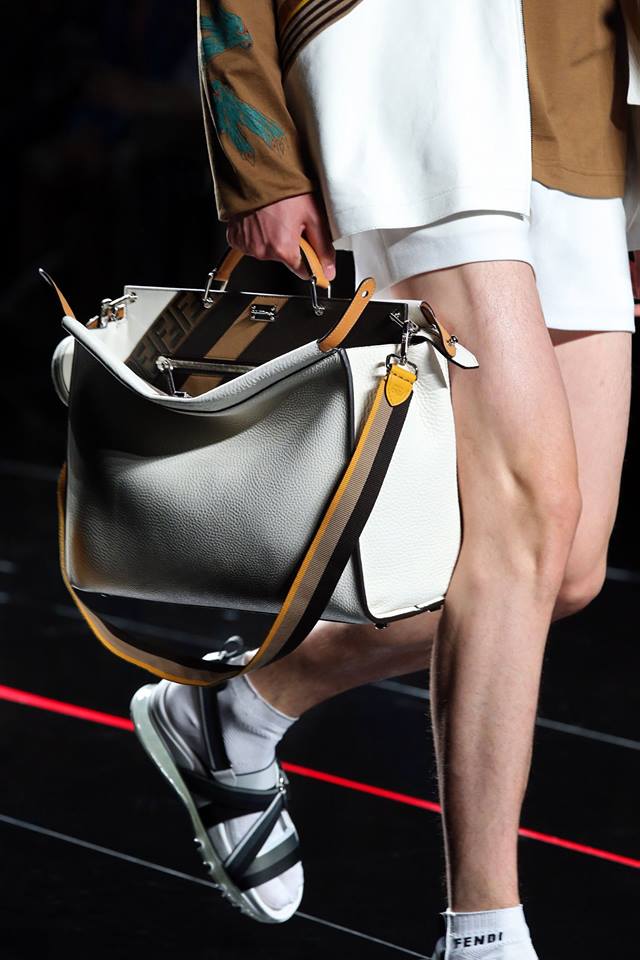If the positioning of politics within fashion feels a bit problematic, on the final day of the shows in Milan, at least one party line had been drawn: in menswear, logos are going nowhere.
This was perhaps most surprising from Giorgio Armani, the king of understated chic. Hosting the show in his favoured concrete auditorium, the Italian designer had hung a billowing white curtain at the end of the catwalk, embellished with a large “GA” logo from the 1980s archive. At Fendi, which took place nearby a few hours later, there were logos on almost every single piece.

The rest of Armani’s collection was logo-free, with the designer taking a deep dive into the double-breasted suit, recast in chalk white, hemp grey and blue for summer. Save for a few large knapsacks, loafers and espadrilles, accessories were minimal, so the models carried their grosgrain hats like handbags.
Suits are an Armani mainstay, but the shape, styling and mood changes each season. Updates came in the shape – high-waisted gaucho-style trousers, with unconstructed jackets that were zoot-like in cut – and in the styling, worn over T-shirts, or waistcoats, in leather, knits, tie-dye prints. The mood was predominantly louche and, like the logo, 1980s in proportion; there was more than a whiff of Richard Gere in American Gigolo on display.
Elsewhere, Armani broke fashion rules by casting silky blouses as jackets and jackets as blouses. In the show notes, the designer suggested the suits be worn “casually, on the beach”. Any queries over the practicality were swiftly hushed by the penultimate two models who walked together, bare-chested, with their jackets almost completely open.
At Fendi, logos were as prescient on the catwalk as they were off. As fans scrabbled for photos of K-pop stars in logo-heavy cross-body bumbags and buckets hats outside, inside the audience were sated by the same aesthetic, with logos appearing on backs, jackets, tops, sleeves, and even sock toes.
Fendi has recently begun collaborating with artists, most memorably Sue Tilley in 2017. This season creative director Silvia Venturini Fendi worked with Italian multidisciplinary artist Nico Vascellari. Part of Italy’s hardcore punk scene, Vascellari went straight for the jugular, turning “Fendi” into an anagram with the words “amor” and “fiend” on neon lights at the end of the catwalk, and on the pieces themselves.

Accessories are the most lucrative aspect of any luxury house, in particular bags, and at Fendi they dominated. There were totes, bucket bags and clutches, weekend bags and bumbags worn several different ways. Every model carried one. Some carried two. Expect the Peekaboo X-Lite bag – a large tote with the middle frame removed – to be a social media fixture. The bags too shifted under the weight of old logos and new ones, layered up and even overlapping in a hyperbolic fashion.
The clothes played second fiddle, with the show notes describing them as easy staples. Here, that meant short shorts (another Milanese theme) alongside spring clothes suitable for rain. Transparent raincoats and anoraks were worn with track pants and knitted polo shirts, and everything came in a palette of red, black, white and brown.

The focus on logos makes financial sense. The Armani group is Italy’s second-largest fashion company after Prada, but its strategy of offering seven lines has been under scrutiny (he now has three diffusion lines: Giorgio Armani, Emporio Armani and the lower priced Armani Exchange).
Fendi, meanwhile, is attempting to court the millennial market by rolling out a new logo, a double F based on the 1974 iteration. In turn, sales of accessories at LVMH, the conglomerate that owns Fendi, were reportedly up almost 20% last year.

guardian.co.uk © Guardian News & Media Limited 2010
Published via the Guardian News Feed plugin for WordPress.


